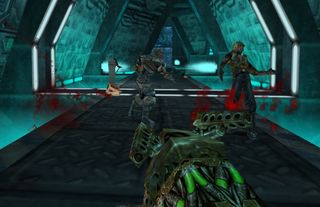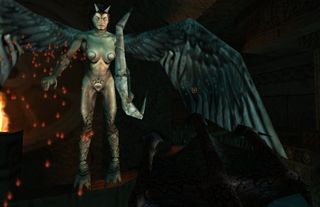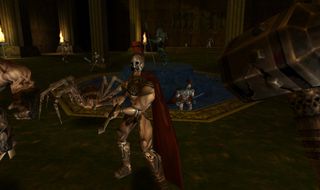Meet the superfans who spent a decade bringing Daikatana back to life
Not many loved Ion Storm's shooter, but those who did loved it enough to resurrect it.

Daikatana is, without a doubt, one of the most infamous video games in history. John Romero left id Software with his voracious enthusiasm for the devil intact. Ion Storm got their hands on the fabulously boxy Quake II engine, and they intended to build the samurai successor to the juvenile blood-soaked grandeur of Wolfenstein and Doom. Time Magazine breathlessly volunteered that Romero—he of flowing ebony locks and skull-patched jackets—was incapable of failure. “Everything Romero touches turns to gore and gold,” wrote reporter Michael Krantz. Well, I guess he was half-right.
John Romero did technically make us his bitch, considering how many people found themselves buying a bad game. It’s clear that Daikatana wanted to be great—there’s an embarrassing amount of world-building and Half-Life style in-engine cutscenes to flesh out the adolescent story bible—but the gameplay was tedious, frustrating, and as PC Gamer wrote in its review, about three years out of date. The touted RPG mechanics turned out to be a bare-bones skillpoint ladder that offered barely noticeable thresholds on, like, the height of your jump. You had two sidekicks, who were programmed with the expected acumen of late-'90s AI. It was an immediate game over if either of them died.
Today Daikatana is often lumped in with worst-of-all-timers like E.T. and Ride To Hell: Retribution. But that was never fair. There was nothing exceptional about Daikatana’s defeat—it failed in the way ambitious first-person shooters often fail. Romero’s clout as the first celebrity game designer made him an easy target. The mind behind Doom, drunk on success, tries to make the most metal game ever and fails.
The narrative is perfect, but leaves one thing out: the people who love Daikatana enough to still play it years later.

I used to fight and argue in chat rooms and forums against those people, who really hate the game I enjoy so much.
Martin Müller
“When Daikatana came out I was pretty young and not as experienced as I am today. I used to fight and argue in chat rooms and forums against those people, who really hate the game I enjoy so much,” says Martin Müller, a 34-year-old German who works in the IT department of the government police. “I couldn't understand why our opinions are exactly the opposite. I wanted to convince them to ‘my’ opinion. I think I sometimes somehow had success, when some people wrote 'hey, it's not as bad as everyone says.' Or when players finished the game with the sidekick off option for the first time. Today I am a little older and don't bother to argue with those people. Everything has been said. Believe me, no one, except maybe John Romero, knows this better than me.”
On November 18, 2001, Müller started Daikatananews.net, the preeminent fan-site for everyone’s favorite video game Titanic. It’s a tiny hamlet of news, notes and oddities relating to everything Daikatana and everything John Romero. The site is still updated to this day, serving as a nexus point for a small group of Daikatana apologists.
“There simply weren't that many players left after 2002,” says Müller. “People moved to other games. Mplayer [the server they played on] closed its doors. The successor Gamespy Arcade, wasn't as successful and never got the players' approval. But I never rediscovered the game. Never had to. It is and was always there."
PC Gamer Newsletter
Sign up to get the best content of the week, and great gaming deals, as picked by the editors.
Müller tells me he’s been playing Daikatana since release, but describes the years between 2002 and 2007 as a “dark period” for the community. It's hard to keep people dedicated when computers are outpacing a game’s capabilities and there’s no sequel on the horizon. But that changed thanks to Frank Sapone, a 28-year-old IT professional in Pennsylvania, who received a copy of Daikatana from his grandmother on Christmas in 2000.
Daikatana reborn

“Some time in about 2006 or so I was mapping for a mod, Missing Information/177, for Half-Life 2. For fun, I decompiled [a Daikatana multiplayer map] and fixed the brush work and made a working deathmatch level,“ he says. “I sent the work to Romero and he was impressed enough to give me the map sources and later on I asked him about having the entire source code. He asked me to ship out an empty hard drive to him. He copied the contents of the entire tape backup he had before he left Ion Storm and overnighted the HDD back to me.”
To Sapone’s dismay, the 1.2 version of Daikatana’s source had a corrupted directory, and there were “some special macros I didn’t know how to fix.” He was operating on C++ and Java courses from high school, and retrofitting an ancient PC shooter was a daunting task. Sapone shelved the project and moved on. But five years later, he started fooling around with computers again.
I never rediscovered the game. Never had to. It is and was always there.
Martin Müller
“I wanted to play some Doom, Heretic, etc. and started playing around with getting these DOS machines online with packet drivers. At some point, I found neozeed/Jason Stevens, and saw that he did a somewhat updated DOS port of Quake 1,” he says. “I found a few bugs, emailed him about it and some of the bugs he didn't really know how to fix. So at this point I started teaching myself enough code… a few months later of nightly coding marathon sessions I started thinking more about the broken Daikatana 1.2 code and started plugging away at it and got it to finally compile.”
Sapone was so overjoyed that he actually woke up his wife. There is nothing more geeky, and more lovable, than disturbing your loved one's sleep patterns over broken Ion Storm code. He emailed his breakthrough to Romero, and gathered other modders in the community, and immediately got to work on Daikatana 1.3—a homebrew patch that makes the Daikatana playable on Linux and Mac.
Daikatana 1.3 comes with HD texture support, glowmap support, multiplayer through QTracker, and perhaps most importantly, the ability to either make your sidekicks invincible or turn them off entirely. It took a decade, but there’s finally an optimal way to suck it down.
There are power-gamers who bleed for hours on perfect Garry’s Mod contraptions, or total conversions of classics like Black Mesa. There are teenagers recreating the galaxy in Minecraft, eager for some front-page Reddit dopamine. The people murking around the Daikatana code will never earn the same viral relevance—this is a project for the cult, by the cult.
And that’s what makes it beautiful. Ion Storm is dead. John Romero is a dad. If Daikatana was going to live again, it was up to them.

It took a decade, but there’s finally an optimal way to suck it down.
“Sometimes, people ask me what coding projects I do beyond QDOS and Q2DOS, and when I mention Daikatana 1.3 they laugh and that's OK,” says Sapone. “My goal is to get Daikatana in a mostly bug-free, playable experience so people can realize how much fun the game truly holds. Especially if you're a fan of 90s FPS.”
Today, you can buy Daikatana on Steam for $7. It’s been on the marketplace since 2013. Sapone tells me a user named Dekonega has been “invaluable” for organizing weekly Saturday matches. "Last week we had over 12 active players on multiple maps and it was a good session,” he says. "Those large matches he has organized over the years has helped me find bugs in the code as well—they really push the limit on how stable the code truly is."
Daikatananews.net’s most recent post is from last October. "Happy Halloween with a new Daikatana 1.3 Linux build!" The fans of a laughing stock have outlasted almost every other ‘90s shooter, and unbelievably Daikatana still has a future.
"With Daikatana 1.3 the acceptance of the game went really, really upwards. People enjoy it more than ever before," says Müller. "This is all which matters in the end: that we have a fun time with the game and the die-hardest gaming community, I know."
To play Daikatana today, join the Daikatana Multiplayer Association on Steam. It currently has 131 members. 12 of them are in-game right now.

Luke Winkie is a freelance journalist and contributor to many publications, including PC Gamer, The New York Times, Gawker, Slate, and Mel Magazine. In between bouts of writing about Hearthstone, World of Warcraft and Twitch culture here on PC Gamer, Luke also publishes the newsletter On Posting. As a self-described "chronic poster," Luke has "spent hours deep-scrolling through surreptitious Likes tabs to uncover the root of intra-publication beef and broken down quote-tweet animosity like it’s Super Bowl tape." When he graduated from journalism school, he had no idea how bad it was going to get.
Most Popular



